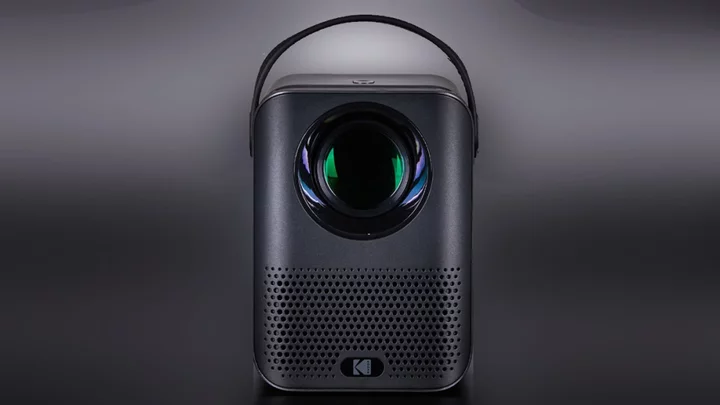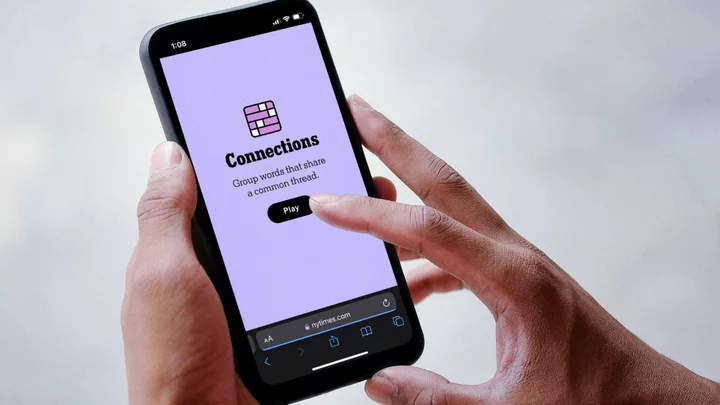The Kodak Flik HD9 Smart Projector ($249.99) is a small step down in price from the Kodak Flik HD10, but it's also a little more capable in two surprising ways. Both projectors display in full HD (1080p, or 1,920-by-1,080-pixel) native resolution, but the HD9 also accepts 4K HDR input via HDMI (down-converting the image to 1080p) and handles high dynamic range (HDR) content visibly well, neither of which are officially supported features. On the downside, in testing we found that it also delivers a little less brightness than its 200-lumen rating promises. If you care more about image quality than image size, you'll be happy with the tradeoff.
Design: A Lunchbox-Style Projector
Setting up the HD9 is straightforward. It's basically a small box with a handle on top, though at 5.9 by 5.4 by 4.3 inches (HWD) and 3.1 pounds, it's easy to move from one spot to another even if you ignore the handle. Setup involves little more than connecting the power cord and a wired or wireless video source, pointing the lens at whatever you're using for a screen, and focusing.
As is typical for mini projectors, you'll find no optical zoom. Kodak includes a digital zoom, but even more than with most projectors, it's best to ignore it and adjust image size by moving the projector. Digital zoom lowers brightness, and even at its brightest, the HD9 could use a boost. You'll want to wring out every lumen you can get from it. You should also avoid using the digital keystone correction, for the same reason.
(Credit: Kodak)The Android TV setup is standard, using Wi-Fi as the only choice for connecting to the internet. As with more and more Android TV-based projectors—though far from all—the HD9 includes a Netflix app that's both easy to use and worked without problems in my tests. The projector uses a single remote for controlling both streaming and the projector settings.
The projector's ports are on the rear panel. They include one HDMI input and a USB Type-A port for reading files from USB memory, powering an HDMI dongle, and loading firmware updates.
(Credit: Kodak)Kodak rates the HD9's brightness at 200 lumens, which according to the Society of Motion Picture and Television Engineers (SMPTE) recommendations is bright enough for a 55-to-74-inch, 16:9 image when using a 1.0-gain screen in a dark room. In my tests, I settled on a 39-inch diagonal image size for the minimum brightness I felt comfortable with on a 1.1-gain screen, which boosts brightness by 10%. Anything larger felt too dim to watch without tiring my eyes. That's roughly the size I would expect to need for viewing a 110-lumen projector's image in a dark room.
While the low brightness could be a deal-breaker for some people, a key feature the HD9 shares with the HD10 and with some other mini home entertainment models, including the Vankyo Performance V700W and NexiGo PJ20, is that it doesn't show rainbow artifacts. Kodak was unable to confirm design details beyond the fact that the HD9 uses a single, large LCD and a white LED light source. However, that's enough to know that it takes the same approach as the HD10, V700W, and PJ20 of using an LCD matrix of 5,760 by 1,080 pixels along with red, green, and blue filters over individual cells. Each set of the three primaries serves as a single pixel, giving a 1,920-by-1,080-pixel resolution. The white light shining through the filters lets it project all three primary colors at once, instead of one at a time, giving the rainbow-free image. The LED light source is rated at 30,000 hours.
The onboard sound system is built around dual 3-watt speakers. In my tests, it delivered usable though somewhat clipped audio at suitable volume for a small or medium-size family room. You can also connect an external sound system via either the 3.5mm audio-out port or Bluetooth.
Testing The Flik HD9: Surprisingly Effective Image Quality
The HD9 menus include three predefined picture modes and one Personal mode, which most other projectors would call a User mode. After some preliminary testing, I chose it for my viewing tests, both because it was one of the brighter modes, and because it was the only one that lets you adjust settings for brightness—which I tweaked for my tests—as well as contrast, hue, saturation, and sharpness. You can also set color temperature for any of the modes.
(Credit: Kodak)The image quality for 1080p SDR material was at the high end of the range for inexpensive mini projectors. Colors were well saturated, and color coverage was far better than merely good enough. The image lost some shadow detail, but even in the darkest scenes in our test clips I could still make out what was going on. Brightly lit scenes delivered deep enough contrast along with broad enough color coverage.
Even better, the HD9 handled 4K HDR input well, despite officially supporting neither 4K nor HDR. Brighter scenes were a little darker than they should be, but shadow detail in both dark scenes and dark areas in otherwise bright scenes was noticeably improved compared with the SDR versions of the same scenes in the same movies.
As is standard for single-chip LCD mini projectors, this one has no support for 3D.
The HD9's input lag is suitable for strictly casual gaming. I measured it using a Bodnar meter at 72 milliseconds for 1080p 60Hz input.
Verdict: A Fine Choice for Dark Rooms and Small Screens
The HD9's low brightness makes it best suited for viewing in a dark room or in a backyard (assuming you have a convenient outdoor power outlet) on dark nights only. Within that context, however, it can deliver image quality that's better than typical for a mini projector, and its built-in Android TV plus Netflix will let you stream movies and video from any location that can connect to the internet.
With that in mind, if you want a larger image, consider any of the other projectors mentioned above. The Vankyo V700W is the brightest, while the NexiGo PJ20—which proved as bright as the Kodak HD10 on our tests—is the least expensive at this writing. The HD10 is the only one of these three with built-in streaming features, but you can always add a third-party streaming dongle to either the V700W or PJ20 if you need to.









